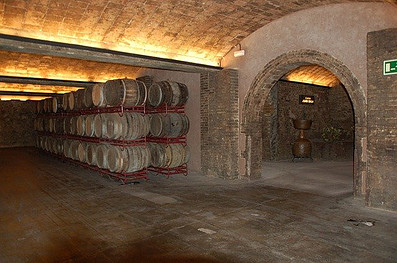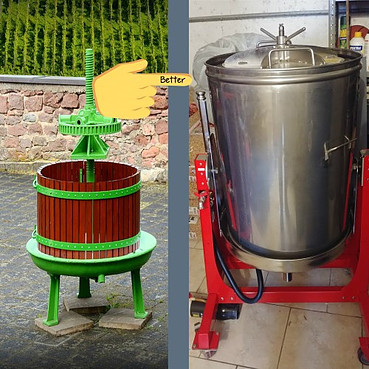A wine cellar is a place dedicated to the care and storage of wine. In this article, therefore, we will write everything about the wine cellar equipment. There are many processes in wine cellars. We can speak about many processes in the long path, from grape picking to the maturity of precious wine. Of course, we should not forget even about the preparation of wine for sale.
About the Spaces in the Wine Cellar
The wine cellar must be of the right size, depending on the amount of grape and wine we have. The wine cellar should be reasonably cold, moist, and dark, usually built underground. It must have separate spaces, at least for grape processing, alcohol fermentation, and wine storage. The temperature in the basement should be between 10 and 20 ° C. For white wines, the temperature in the cellar is slightly lower, and for red wines slightly higher. The moisture in the basement depends on the containers we have in the basement. Wines kept in metal and other tanks should have a moisture content of about 70%; for wines in wooden containers, between 80 and 90%.
Due to the rapid changes in temperature caused by the weather, the basement should be well insulated. Good electrical insulation, cold and hot water supply should be provided here, and water outflow and carbon dioxide removal should be required.
Spaces and floors in the basement should be easy to clean, as basement hygiene is our main concern throughout the year.
Ask yourself the following questions and try to answer them. If you would like me to write a blog about these issues, let me know in the comment.
1. What kind of spaces should a modern wine cellar have?
2. Why the cellar must have separate spaces for grape processing, alcoholic fermentation, and wine storage.
3. Why is hygiene in the basement a significant concern?
4. Why is it necessary to ensure the drainage of carbon dioxide from the cellar during alcoholic fermentation?
Everything About the Wine Cellar Equipment
The wine cellar equipment is used to process grapes, store must and wine, pump, filter and bottle wine, etc. Today we find a number of manufacturers and suppliers of various wine cellar equipment on the market. The equipment in the cellar includes wine containers, destemmers and crushers, pumps, presses, filters, wine-filling equipment, bottles, stoppers and caps, and other equipment.
Wine Containers as the Most Recognizable Piece of Wine Cellar Equipment
The wine containers serve us for storing wine and are the most recognizable piece of equipment in the cellar. We have wooden wine containers (barrels), stainless steel containers, plastic containers, concrete containers, and glass containers. Our modern cellars are predominantly wooden containers(barrels) and stainless steel containers.
Stainless Steel Containers
Stainless steel containers are currently the most common in our basements. This container has a wide range of uses and is easy to clean and maintain. The shape of the container can be adjusted to space. It is resistant to must, and wine ingredients are impermeable, easy to cool and warm, and have a long shelf life.
Wooden Barrels
Wooden barrels are one of the oldest wine storage vessels. Due to their porosity and contact with wood, wooden barrels allow red and white wines to mature. The wooden vessels are mainly made of oak wood, but other types of wood can be found (cherries, mulberries, chestnuts, acacia trees, etc.).
Today, wooden barrels are indispensable for the production of red wines. The weakness of the wooden vessel is mainly difficult maintenance (bending, canning), reduced space utilization, and limited duration. In the case of poor cleaning, it has a negative effect on the wine. The high price of wooden barrels is also problematic. Wooden barrels require special care in cleaning and maintenance.
Plastic Containers
Plastic containers are still used in some places, but they have lost most of their advantages over stainless steel containers. They are mainly used for the transport of grapes, mash, or must as intermediate vessels for flow, cleaning, and filtration.
Wine Fermentation Tank
The wine fermentation tank is a special container for the maceration of red mash. It works on the principle of pouring, dipping, and mixing the mash. During the alcoholic fermentation, the wine fermentation tank produces CO2, through which the mash in the container is overflowing, dipping and stirring. The wine’s fermentation tank is equipped with a thermoregulation system. There are two types of wine fermentation tanks: submersible and overflow. Wines fermentation tanks can also be used to store wine.
Destemers and Crushers
The destemer and crusher are indispensable for grape processing, especially for red varieties. With the destemer we separate the stems from the berries, and with the crusher, we press or open the berries. Destemer and crusher usually occur in combination.
The crusher consists of two or four opposite cylinders that do not touch each other. Cylinders must be adjustable because the berries should be squeezed only so much that the grape juice leaks out. Strawberries should not be crushed, nor should they be damaged. The destemer and crusher must be easy to clean and maintain.
Presses
Presses are devices for pressing grapes or mash. They operate on the principle of overpressure on grapes or mash so that the must containing the minimum amount of solid parts flows out. Presses are divided  into mechanical, hydraulic, and pneumatic.
into mechanical, hydraulic, and pneumatic.
Today, the most widely used are pneumatic presses that operate with compressed air. The stainless steel drum is clamped horizontally in two supports so that it can rotate. Inside of the drum, a special rubber membrane fills with air and presses the mash (grapes). The must flows through special strainer channels located in the center of the drum.
The advantage of pneumatic presses over other presses is that the compression is computer-controlled (automatic) and is performed at low pressure (up to 1.2 bar). Low-pressure compression does not result in mechanical damage to the grape berries and stalks. So squeezing is effective – the juice is thoroughly squeezed out and at the same time of good quality, but not loaded with substances from the hard parts of the grapes.
It would help if you always adapted the compression to the characteristics of the grapes. You also must take the grape variety, the degree of ripeness, and the stalk ratio to the berries into account. Before squeezing grapes, we also determine what style of wine and what type of wine we want to get.
Filters and Filtration
Wine filtration is a process by which the impurities and microorganisms in the wine are removed.
The impurity is retained on the filtration layer through which the wine passes. Filtration removes coarse or fine particles, depending on the stage of wine production.
With the development of wine technology, different types of filters have emerged on the market. Thus we know the floating filter, the vacuum rotary filter, the plate filter, the filter press, the membrane filter, the tangential filter, and the like.
There are two ways to remove particles when filtering:
- withholding (sieve effect) and
- by absorption.
Filtration by degree is divided into:
- coarse filtration,
- fine filtration and
- sterile filtration.
Wine Bottling Equipment
Wine bottling equipment depends on the amount of wine produced. Smaller winemakers are still bottling with basic equipment consisting of a bottle charger, a stopper, and a bottle sterilizer. Larger winemakers mostly use automatic or semi-automatic bottling lines. These lines are automated from bottle preparation to label affixing or even packaging.
Bottles
The most commonly used wine packaging is a bottle (glass) of various shapes and volumes. They are watertight and do not react with the wine. Today, wine is also being bottled in cardboard boxes containing a plastic bag with wine of varying volumes. The said packaging is mainly used for open wines. Although some winemakers are disgusted with their use, the said packaging is increasing in most countries.
Stoppers and Caps
There are various bottle closures on the market. Cork stoppers, synthetic stoppers, screw caps, and crown caps are used to close the bottles. The type of stopper depends on the bottle. The stoppers must be impenetrable and sealed.
Other Equipment
In wine cellars, the following equipment is also used in the processing of grapes, such as vats, pipelines, pipes, boiling points, heaters, and coolers for temperature control, mixers, installations for inert gases, equipment for determining physicochemical parameters, etc.
